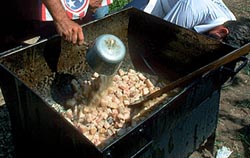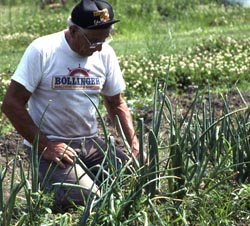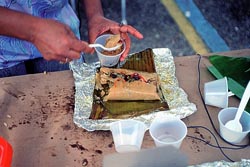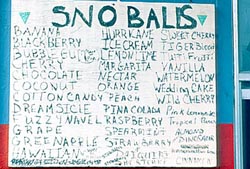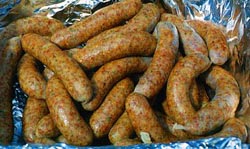Louisiana's Food Traditions: An Insider's Guide
By Maida Owens
Louisiana's complex blending of cultures over 300 years produced distinctive regional food traditions for which we are known worldwide. But we have other food traditions that are not so well known. Each cultural group has retained food traditions, and even within cultural groups, traditions vary from community to community, and family to family.
Food traditions are particularly intriguing because they are some of the most persistent of traditions. Generally, people resist changing their food patterns. As a result, food often becomes closely tied to cultural identity and can reveal cultural processes such as blending, diffusion, or maintenance.
Gumbo is an excellent example of cultural blending, or creolization. This dish so closely identified with South Louisiana, melds African, European, and Native American cultures. The word itself is derived from the Bantu word for okra, nkombo. The okra plant, a favorite in Africa, is a Middle Eastern plant brought to America by Portuguese traders. Filé (ground sassafras leaves) is Native American. The origin of gumbo—usually defined as a soup-like dish featuring two or more meats or seafood and served with rice—is often attributed to the French bouillabaisse, but the strong preference for soups in Africa reinforced the tradition.
Any gumbo researcher soon discovers that there are many types and that there is no consensus about what makes a good gumbo. If your family prefers an almost black roux, your family probably has ties to the prairies west of the Atchafalaya Basin. If your family prefers a lighter roux or you add tomatoes, you are more likely to have ties to southeast Louisiana east of the Atchafalaya.
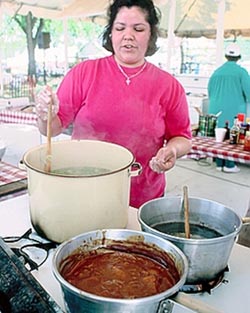
Although people in all parts of South Louisiana make meat and sausage gumbo thicken with filé, seafood gumbo thickened with okra is more common along the coast, where seafood is more plentiful. If you make duck, venison, or squirrel gumbo, you most likely have a hunter in the family. If you put a scoop of potato salad in your gumbo before serving, you likely have some German influence. If you make the much less common, meatless gumbo z'herbes for Lent, you are likely Catholic and your family has been in Louisiana many generations. You are less likely to find this in many of the Cajun and Creole cookbooks so readily available now. And if your family wants to extend the gumbo, you might add boiled eggs.
No matter which type of gumbo you make, though, you likely feel that the gumbo that you make is the "right way" to make a gumbo. If eating and cooking gumbo are favorite pastimes in Louisiana, arguing about what is a good gumbo comes in a close third. And, if you didn't realize that gumbo was so complicated, you likely are recent to Louisiana.
Gumbo also illustrates cultural diffusion, or the spreading of a cultural trait, because even before the Cajun food craze, gumbo, hot sauce, and other south Louisiana foods spread into North Louisiana and south Mississippi. The likelihood of these foods being family traditions is proportionately related to the distance from South Louisiana. In other words, people in North Louisiana, east Texas, and south Mississippi are more likely to make gumbo than people in north Mississippi, Arkansas, and Alabama. One factor is people moving to South Louisiana and New Orleans for jobs, becoming accustomed to the food, and bringing new food traditions back upon their return home.
Cultural maintenance can be illustrated by food traditions in many cultural groups whether they descend from the colonial settlement, were part of the later waves of immigration, or recently arrived, especially in cultural groups that are not part of the dominant cultural group in a region. Food reminds us of home and family and becomes central to special occasions and rituals. As a result, food traditions can be the most resistant to change.
Examples abound throughout Louisiana. The German enclave of Roberts Cove in Acadia Parish still makes sauerkraut. Hungarians have been in eastern Livingston Parish between Albany and Springfield for about 100 years and take special pride in their Hungarian sausage. Filipinos celebrate special occasions with the noodle dish pansit. Croatians in Plaquemines Parish keep goats just so they can make goat milk cheese. The Irish in New Orleans celebrate St. Patrick's Day by parading and throwing to the crowd the ingredients of potato stew.
Some of the most visible markers of Creole French influence in Natchitoches are the foodways: meat pies and Cane River cakes. West of Natchitoches in Los Adais in Sabine Parish, one finds colonial Spanish influences, and again, the primary evidence is in the foodways: tamales and salsa. One food tradition closely tied to Italian-American ethnic identity is the St. Joseph altar with its fig pastries, casseroles, cookies, cakes, and special breads in the form of Catholic symbols. Native Americans have retained some foods that have become symbolic to their identity, including fry bread and Indian tacos. A few Coushatta (Koasati) continue to make hominy soup, which has almost died out, as it is time-consuming and difficult, beginning with grinding the hominy by hand using a mortar and pestle.
The impact of Native American foodways is still seen in food traditions of people descended from the early settlers. Native Americans introduced Europeans and Africans in both north and South Louisiana to corn bread, grits, sweet potatoes, squash, beans, deer, turkey, fish, and such. Then, the newcomers added foods that were most important to them. Europeans brought carrots, turnips, beets, cabbage, and lettuce. Africans contributed okra, yams, peanuts (although originally from South America), watermelon, collards, hot peppers, and pepper sauce. Pork was central to the early settler's diet, and remains important to many.
Scholars divide the state into three major cultural regions—New Orleans, South Louisiana, and North Louisiana, each of which contains groups whose cultures remain distinct from that of the larger region. Distinct food traditions have persisted in each, but those in New Orleans and South Louisiana are entwined.
New Orleans is home to a vast array of food traditions, but it is best known for Creole cooking. At one time, it may have been possible to say that Creole cooking was the fancier cooking of New Orleans with more European influences and Cajun cooking the simpler food of the country folk, but this is no longer true. Today, it is difficult to distinguish between Cajun and Creole cooking as they are practiced in the home. Nowadays when applied to food, the terms Cajun and Creole are frequently used interchangeably or together. But Creole most often refers to the haute cuisine of New Orleans restaurants that developed from the intensive blending of the city's various food traditions, many of which originated with European-trained chefs. For example, Jules Alciatore of Antoine's Restaurant introduced baked fish en papillote (in paper) and oysters Rockefeller. The experimentation continues with such dishes as seafood pasta introduced by Ralph and Kacoo's Restaurant.
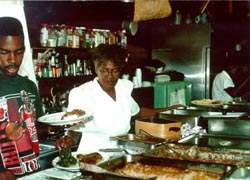
To appreciate South Louisiana foods fully, one must remember that Cajun and Creole cooking are the products of 300 years of continuous sharing and borrowing among the region's many cultural groups. For example, the French contributed sauces (sauce piquante, étouffée, stews, bisque), sweets (pralines, a modified French confection with pecans instead of the original walnuts), and breads (French bread, beignets or square doughnuts with powdered sugar, and corasse, fried bread dough eaten with cane syrup). The Spanish added jambalaya (a spicy rice dish probably from the Spanish paella).
Africans contributed okra, barbecue, and deep-fat frying and reinforced the Spanish preference for hot spices and soups. Germans, who arrived in Louisiana before the Acadians, contributed sausages (andouille and boudin) and "Creole" or brown mustard. Caribbean influence is seen in the bean and rice dishes of red beans and rice and congri (crowder peas and rice). Native Americans contributed filé and a fondness for corn bread. Many of these foods are generally known, but far fewer are aware of lesser-known food delicacies in Louisiana as the prairie Cajun langue boureé (stuffed beef tongue) or chaudin (sausage-stuffed pork stomach).
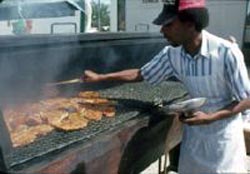
One distinction about food in New Orleans and South Louisiana is that food is regarded as far more than mere sustenance. Food is relished, and the standard for merely adequate cooking is much higher here than in other parts of the country. Just as people argue over the right way to make a gumbo, they enjoy talking about food, exchanging recipes, and collecting cookbooks. "What did you eat last night?" is a frequent question. And everyone enjoys experimenting with, preparing, and of course eating food.
It is not surprising that the average cook possesses highly skilled culinary standards. Because both men and women take pride in their cooking—and enjoy any opportunity to show off their skills—every gathering becomes a food event. Family food events in particular become social functions. Through food, families maintain a sense of generation and extension. Older family members pass family lore to the younger ones, and individuals learn about their cultural identity as well as about their nieces, cousins, and aunts.
This has resulted in an environment where foods introduced by newly-arrived cultural groups are appreciated and readily accepted. Most families of the region also enjoy Italian pasta and stuffed artichokes. In New Orleans, every ethnic group claims the muffuletta, a large sandwich with several meats, cheeses, and olive salad.
Other ethnic groups open restaurants featuring new foods that are often highly spiced. The Chinese and Vietnamese have added their food traditions to the regional's culinary history—so much so that Asian restaurants enjoy enthusiastic support and Asian chefs have begun to use such Louisiana fare as crawfish. Kung Pao Crawfish is a standard feature of Chinese lunch buffets in Baton Rouge. Most recently, restaurants featuring the strongly spiced Middle Eastern dishes generally called Lebanese but often actually owned by Palestinians, are well-supported. Japanese, Thai, and Latino restaurants are also appearing and thriving.
North Louisiana food traditions are more closely related to those of the American South than South Louisiana, but food is still central to family and community life. North Louisiana food is less spicy but emphasizes different ingredients and recipes due to different settlement patterns. English-speaking British Americans and African Americans primarily settled North Louisiana which includes the Florida Parishes north of Lake Pontchartrain (in the "toe of the boot" as locals say) and parishes north of the French triangle. Even though the Florida Parishes are closer physically to south Louisiana, they share historic settlement patterns more with north Louisiana and Mississippi.
North Louisiana food traditions include a vast array of jellies, jams, and preserves; vegetable crops (especially corn, sweet potatoes, and greens); hogs; and some cattle. North Louisiana families are fond of a wide range of vegetables, but have a special affinity for beans and peas. Other than English (also know as green or sweet) peas and string or pole beans, which are generally eaten fresh, peas and beans may be picked fresh from the garden, frozen, canned, or dried. Beans varieties include white (or navy), pinto, butter, lima, and white or speckled butter beans. Peas include various varieties of cream, lady, speckled, black-eyed, crowder, cowpeas, or purple-hull. Any of these may be "helped" with homemade relishes (such as green tomato and red tomato relish), tomato sauce, chow-chow, and cucumber or peach pickles.
Corn in its many forms remains a staple, and corn bread continues to be important even though biscuits have become increasingly so in the last century. Corn bread may be baked plain or with cracklins to make cracklin bread, fried with flavorings for hushpuppies, or boiled to make hot water bread. Add eggs, and it becomes egg bread. Green corn is also boiled or roasted fresh, or creamed. Ripe corn can become hominy, and hominy can become grits.
Pork is still, by far, the preferred meat and appears smoked, barbequed, in sausages, cracklings, and vegetables, but many still savor wild game (venison, squirrel, raccoon, rabbit, and quail) and fish (both farm-raised catfish and gamefish such as crappie and bream). Any fish or meat may be fried. Sunday dinners at noon, fish fries, and barbecues are common occasions.
North Louisiana gatherings that feature food include ritual traditions reflecting their Protestant heritage. All-day singings and dinners on the grounds still take place after church services in many rural communities, frequently on the fifth Sunday in a month. Both black and white rural churches have gatherings such as Homecoming, bringing together extended families. Memorial Day, which commemorates all the deceased, not only military veterans, also provides an opportunity for extended families to visit graveyards, decorate graves with silk flowers, tell stories, and, of course, eat.
So, no matter where you are in Louisiana, the food traditions of families and other cultural groups reveal information about the people. It might be settlement patterns, historic connections, migrations patterns, ethnicity, religious or simply family traditions. Research in food tradition is one more way to learn about ourselves and our neighbors.


